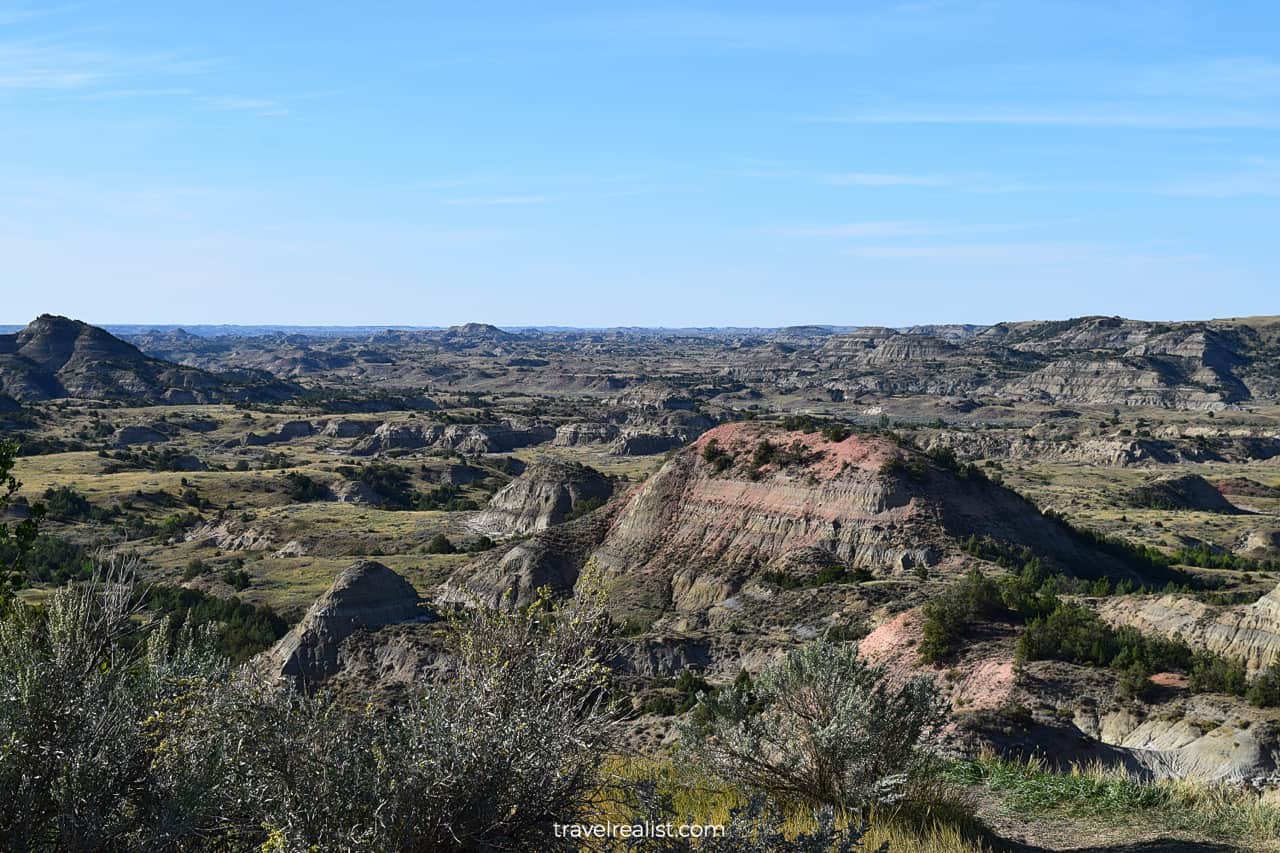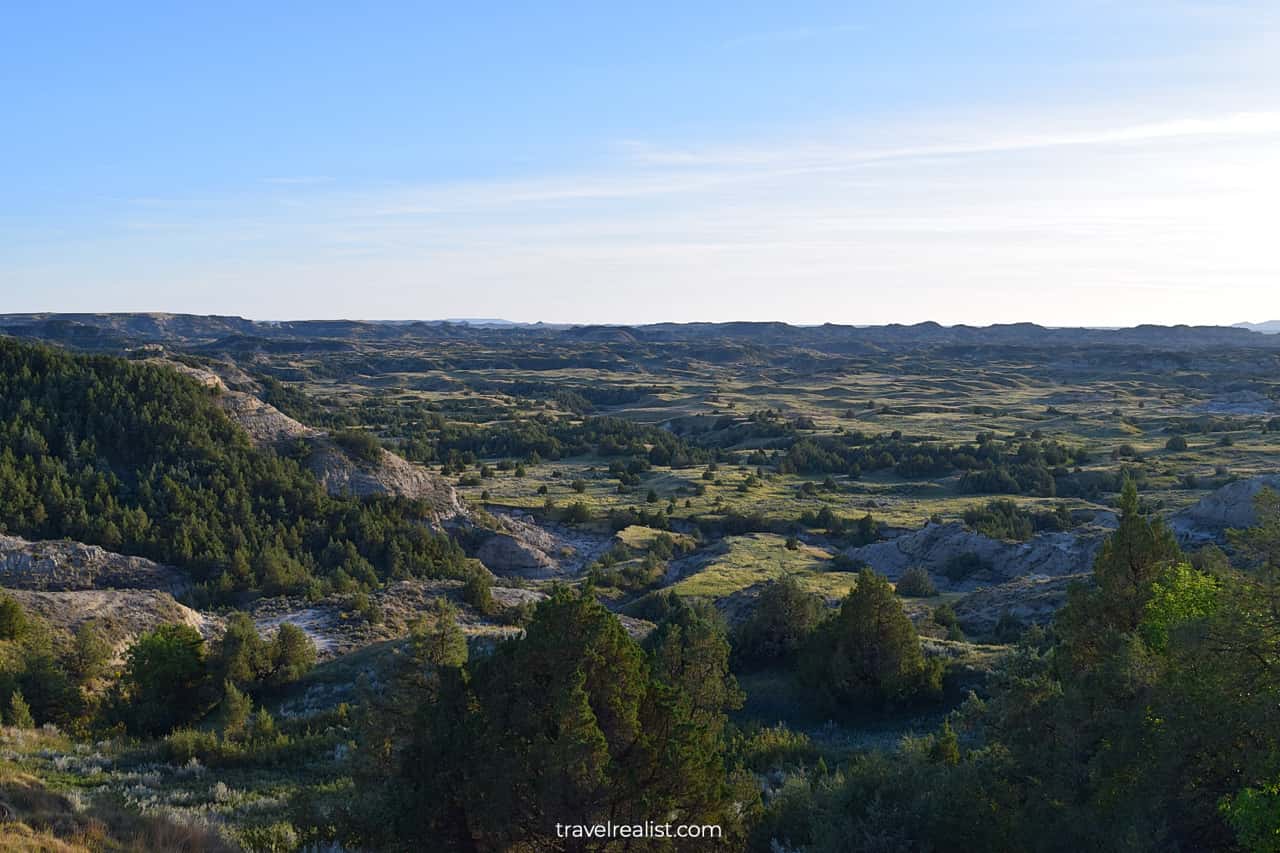Theodore Roosevelt: Bisons in A Very Remote Park

Theodore Roosevelt National Park Guide
Use our realistic Theodore Roosevelt Guide to plan your next adventure in this national park.
Theodore Roosevelt National Park is a park in North Dakota famous for wildlife spotting.
This post includes affiliate links that will earn us commission if you make a purchase via these links.
Sights & Places of Interest
Theodore Roosevelt National Park protects remote landscapes of North Dakota. The park is named after Theodore Roosevelt, the 26th President of the United States. President Roosevelt contributed to the establishment of the first National Parks, Monuments, and Forests.
The park consists of three units: South, North, and Elkhorn Ranch Unit. The first two units are next to major highways. They feature scenic drives, overlooks, and hikes. Elkhorn Ranch Unit is so remote that it does not even have paved roads.
This Theodore Roosevelt Guide focuses on South and North Units.

North Unit
The North Unit features a 14-mile (22-km) one-way Scenic Drive along the Little Missouri River. The Grand Canyon of the Little Missouri River has several overlooks and trails.
Scenic Drive
Allow about 1.5 hours to complete both legs of this drive. You would need even more time if you plan on hiking the trails.
Cannonball Concretions
The Cannonball Concretions Pullout is a trailhead for the Buckhorn and Achenbach Trails. These trails cover over 11 miles (18 km) each. You can hike the whole distance of the Scenic Drive via these two trails. Get ready to cross the river up to two times if you undertake this hike.

River Bend Overlook
The River Bend Overlook provides the first view of the river valley from atop its banks. It also serves as a trailhead for the 1.5-mi (2.4-km) Caprock Coulee Nature Trail.

Oxbow Overlook
The Oxbow Overlook is the Scenic Drive’s final point. It offers fantastic views of the Little Missouri River. You can hike down to the river via the Achenbach Trail.

You need to drive the entire Scenic Drive back to the Visitor Center. This is one of the downsides of the North Unit. On the bright side, you have another chance to stop at any overlooks you missed on the way in.
Once you pass the North Unit Visitor Center, budget about 70 minutes to cover the distance between the two park units.
South Unit
This Theodore Roosevelt Guide will now cover the sights of the park’s South Unit. The South Unit is the park’s main unit. It features a longer Scenic Loop Drive, which is famous for its wildlife encounters.
Painted Canyon
Before you get to the Scenic Loop, you should stop at the Painted Canyon. Painted Canyon is home to a Visitor Center and the Nature Trail. It is the South Unit’s first overlook, right next to Interstate I-94.

Prairie Dog Town
The South Unit soon lived up to its reputation. Countless prairie dogs live in the Prairie Dog Metropolis. These creatures stay even closer to the road than in Badlands National Park.

Cottonwood Campground
While passing the Cottonwood Campground, we noticed a buffalo. There is a very good chance you will see bisons in the park. The South Unit’s herd alone is between 200 and 400 bisons.

Scenic Loop Drive
Wildlife spotting continued when we turned on the Scenic Loop Drive. We chose to drive on the loop counterclockwise.
Another prairie dog town was the next stop. There were lots of wildlife species, from prairie dogs to white-tailed deer.

We saw a flock of turkeys, just minuted from the prairie dog town.

Badlands Overlook
We did not spot any wildlife at either the Scoria Point or Badlands Overlook. But it resumed once we turned to the Buck Hill Trail Road. A mule deer crossed the road towards the Coal Vein Nature Trail.
The South Unit has several trails of varying difficulty. Most of them cover a distance of 7+ miles (11+ km). You would need over half a day to explore the South Unit’s hiking trails.

Buck Hill
The Buck Hill stop features a 0.2-mi (0.3-km) hike to the park’s signature formations. To our disappointment we found that graffiti now cover some of the formations.

The Buck Hill is a great location to catch panoramic views of the park. Thanks to its elevation, you can see for miles and miles.

Boicourt Overlook
The Boicourt Overlook is the next stop on the Scenic Loop Drive. It provided a closer look at the area inside the Loop Drive.
This badlands like landscape featured a lot of more greenery than we expected. Lush meadows and green trees made the view very scenic.

The overlooks became less frequent once the Scenic Loop Drive passed the Boicourt Overlook. But the area of the park around the Jules Creek and the Little Missouri River is another magnet for wildlife. Once the Scenic Drive passed the Peaceful Valley Ranch, it was time to finish our exploration.
Continue with our Theodore Roosevelt Guide to learn more about ways to get to the sights, entrance requirements, and places to stay.
Getting to Theodore Roosevelt
Theodore Roosevelt National Park is a very remote park. The park is in North Dakota, close to the Montana state line. it is also roughly halfway between South Dakota state line and the border with Canada. Most of the park’s sights are along highways I-94 and US-85.
Theodore Roosevelt National Park has three units:
- South Unit: main park unit with a 48-mi (77-km) Scenic Loop Drive, overlooks, and wildlife
- North Unit: more remote park unit with a 28-mi (45-km) Scenic Drive and overlooks
- Elkhorn Ranch Unit: very remote unit with unpaved roads
About 69 miles (111 km) separate the park’s South and North Units. But there is more to it. The units are in different time zones. While the North Unit is in the Central Time zone, both the South and Elkhorn Ranch Units are in the Mountain Time Zone. Keep that in mind when trying to visit several units in one day.
Denver, CO, Minneapolis, MN, and Winnipeg, MB in Canada are the closest airport hubs to Theodore Roosevelt National Park.
Where to Stay
Medora, ND, and Watford City, ND are the closest towns to the park. They have several hotels and vacation rentals to choose from. However, most of them charge a premium for proximity to the national park.
Dickinson, ND is one of the larger towns in the area. It is about 40 miles (64 km) east from the South Unit’s entrance. This detour could be worth it if you would like to save on places to stay.
Entrance Requirements & Passes
Theodore Roosevelt National Park charges admission fees of $30 per vehicle. The park honors America the Beautiful annual passes. There are no federal lands that charge fees for miles and miles from this national park. If Theodore Roosevelt is the only national park you visit in a year, it will be difficult to break even on the annual pass.
The park is open every day of the year. However, the majority of the South Unit’s Scenic Loop Drive is often closed in winter.
Summer is the best time to visit Theodore Roosevelt National Park. The park’s summer high temperatures stay below 83°F (28°C). The average daily low temperatures remain at 54°F (12°C) even during July. And the park’s remote location reduces crowds. This Theodore Roosevelt Guide depicted a summer trip to this national park.

Takeaways: Theodore Roosevelt
Theodore Roosevelt National Park is a nice park. Wildlife viewing opportunities are plentiful. Scenic drives and overlooks provide picturesque views of rivers, valleys, and badlands.
But the park is very remote. A visit to Theodore Roosevelt can easily add a day or two to your trip. If time presents an issue, it is fine to skip this park. Its scenery is memorable but not unique to other national parks and monuments. You can see bisons in less remote Yellowstone National Park and prairie dogs in Badlands National Park.
If time is not a problem or if you are traveling on Interstate I-94, stop by the park’s South Unit. It is easier to reach. And you have better chances of spotting wildlife.
Take a look at our Theodore Roosevelt Video Guide and visit our YouTube channel for the latest videos.
Frequently Asked Questions
Theodore Roosevelt National Park is a scenic destination. However, its remote location makes a visit difficult to plan. If time is an issue, it is best to skip this park. But if you are already in the area, stop by the South Unit.
Theodore Roosevelt has two scenic drives:
– South Unit: it takes at least 90 minutes to drive the Scenic Loop Drive
– North Unit: it takes at least 75 minutes to drive the Scenic Drive
Allow for another 70 minutes to drive between the two units.
Summer is the best time to visit Theodore Roosevelt National Park. The summer weather in North Dakota is comfortable. And the park’s remote location will help with crowds.
The South Unit is easier to reach. It has a longer Scenic Loop Drive and a larger buffalo herd. Both increase your chances for wildlife spotting. But this unit gets more visitors.
For a more remote experience check out the park’s North Unit. While you might spot less wildlife species, you will enjoy the breathtaking views of the Little Missouri River Canyon.
You do not need a reservation to drive the park’s scenic drives or hike during the day. But overnight hikes and camping require an advance reservation.
Theodore Roosevelt National Park charges admission fees of $30 per vehicle.
Drive the South Unit’s Scenic Loop while enjoying wildlife spotting and overlooks.
Safe realist travels!




